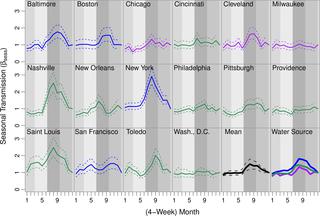当前位置:
X-MOL 学术
›
PLOS Negl. Trop. Dis.
›
论文详情
Our official English website, www.x-mol.net, welcomes your feedback! (Note: you will need to create a separate account there.)
Changes in historical typhoid transmission across 16 U.S. cities, 1889-1931: Quantifying the impact of investments in water and sewer infrastructures.
PLOS Neglected Tropical Diseases ( IF 3.8 ) Pub Date : 2020-03-18 , DOI: 10.1371/journal.pntd.0008048 Maile T Phillips 1 , Katharine A Owers 1 , Bryan T Grenfell 2 , Virginia E Pitzer 1
PLOS Neglected Tropical Diseases ( IF 3.8 ) Pub Date : 2020-03-18 , DOI: 10.1371/journal.pntd.0008048 Maile T Phillips 1 , Katharine A Owers 1 , Bryan T Grenfell 2 , Virginia E Pitzer 1
Affiliation

|
Investments in water and sanitation systems are believed to have led to the decline in typhoid fever in developed countries, such that most cases now occur in regions lacking adequate clean water and sanitation. Exploring seasonal and long-term patterns in historical typhoid mortality in the United States can offer deeper understanding of disease drivers. We fit modified Time-series Susceptible-Infectious-Recovered models to city-level weekly mortality counts to estimate seasonal and long-term typhoid transmission. We examined seasonal transmission separately by city and aggregated by water source. Typhoid transmission peaked in late summer/early fall. Seasonality varied by water source, with the greatest variation occurring in cities with reservoirs. We then fit hierarchical regression models to measure associations between long-term transmission and annual financial investments in water and sewer systems. Overall historical $1 per capita ($16.13 in 2017) investments in the water supply were associated with approximately 5% (95% confidence interval: 3-6%) decreases in typhoid transmission, while $1 increases in the overall sewer system investments were associated with estimated 6% (95% confidence interval: 4-9%) decreases. Our findings aid in the understanding of typhoid transmission dynamics and potential impacts of water and sanitation improvements, and can inform cost-effectiveness analyses of interventions to reduce the typhoid burden.
中文翻译:

1889年至1931年间在美国16个城市中伤寒传播的历史变化:量化对供水和下水道基础设施投资的影响。
据信,对水和卫生系统的投资已导致发达国家伤寒的发生,因此大多数病例现在发生在缺乏足够清洁水和卫生设施的地区。探索美国历史伤寒死亡率的季节性和长期变化模式可以使人们更深入地了解疾病的驱动因素。我们将修改后的时序易感性感染恢复模型与城市水平的每周死亡率进行拟合,以估计季节性和长期的伤寒传播。我们按城市分别检查了季节性传播,并按水源进行了汇总。伤寒传播在夏末/初秋达到顶峰。季节性因水源而异,最大的变化发生在有水库的城市。然后,我们拟合层次回归模型,以测量长期输水和自来水和下水道系统的年度财务投资之间的关联。历史上人均$ 1(2017年为$ 16.13)的供水总投资与伤寒传播减少约5%(95%置信区间:3-6%)有关,而下水道系统总投资增加$ 1与估计的相关降低6%(95%置信区间:4-9%)。我们的发现有助于了解伤寒传播的动态以及水和卫生设施改善的潜在影响,并且可以为减少伤寒负担的干预措施提供成本效益分析。2017年有13个)供水投资与伤寒传播减少约5%(95%置信区间:3-6%)相关,而下水道系统总投资增加1美元与估计6%(95%置信度相关)间隔:4-9%)减少。我们的发现有助于了解伤寒传播的动态以及水和卫生设施改善的潜在影响,并且可以为减少伤寒负担的干预措施提供成本效益分析。2017年有13个)供水投资与伤寒传播减少约5%(95%置信区间:3-6%)相关,而下水道系统总投资增加1美元与估计6%(95%置信度相关)间隔:4-9%)减少。我们的发现有助于了解伤寒传播的动态以及水和卫生设施改善的潜在影响,并且可以为减少伤寒负担的干预措施提供成本效益分析。
更新日期:2020-03-19
中文翻译:

1889年至1931年间在美国16个城市中伤寒传播的历史变化:量化对供水和下水道基础设施投资的影响。
据信,对水和卫生系统的投资已导致发达国家伤寒的发生,因此大多数病例现在发生在缺乏足够清洁水和卫生设施的地区。探索美国历史伤寒死亡率的季节性和长期变化模式可以使人们更深入地了解疾病的驱动因素。我们将修改后的时序易感性感染恢复模型与城市水平的每周死亡率进行拟合,以估计季节性和长期的伤寒传播。我们按城市分别检查了季节性传播,并按水源进行了汇总。伤寒传播在夏末/初秋达到顶峰。季节性因水源而异,最大的变化发生在有水库的城市。然后,我们拟合层次回归模型,以测量长期输水和自来水和下水道系统的年度财务投资之间的关联。历史上人均$ 1(2017年为$ 16.13)的供水总投资与伤寒传播减少约5%(95%置信区间:3-6%)有关,而下水道系统总投资增加$ 1与估计的相关降低6%(95%置信区间:4-9%)。我们的发现有助于了解伤寒传播的动态以及水和卫生设施改善的潜在影响,并且可以为减少伤寒负担的干预措施提供成本效益分析。2017年有13个)供水投资与伤寒传播减少约5%(95%置信区间:3-6%)相关,而下水道系统总投资增加1美元与估计6%(95%置信度相关)间隔:4-9%)减少。我们的发现有助于了解伤寒传播的动态以及水和卫生设施改善的潜在影响,并且可以为减少伤寒负担的干预措施提供成本效益分析。2017年有13个)供水投资与伤寒传播减少约5%(95%置信区间:3-6%)相关,而下水道系统总投资增加1美元与估计6%(95%置信度相关)间隔:4-9%)减少。我们的发现有助于了解伤寒传播的动态以及水和卫生设施改善的潜在影响,并且可以为减少伤寒负担的干预措施提供成本效益分析。


























 京公网安备 11010802027423号
京公网安备 11010802027423号